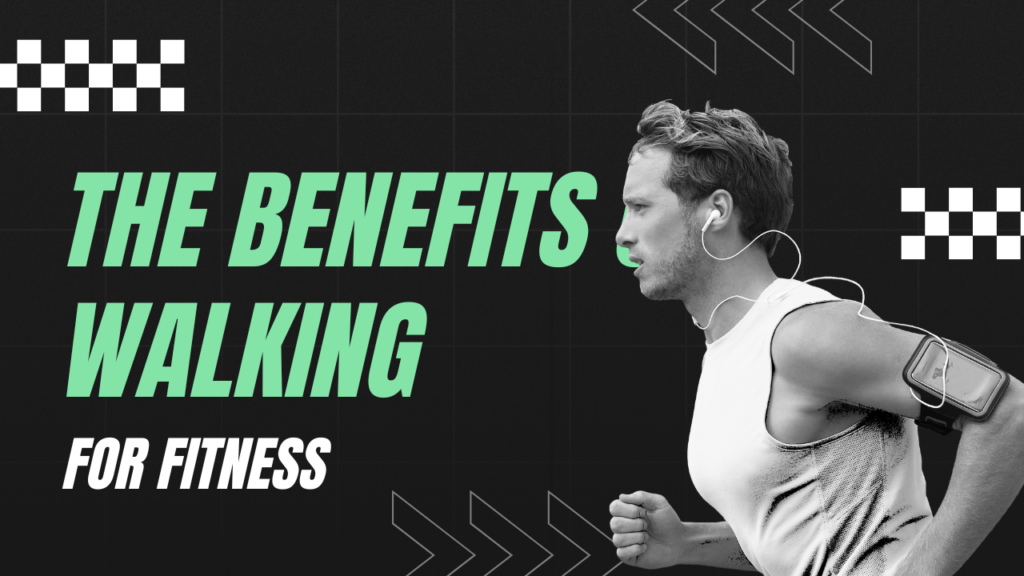The Benefits of Walking for Fitness
Introduction:
Walking is a simple yet powerful form of exercise that offers numerous benefits for both physical and mental health. It requires no special equipment, can be done almost anywhere, and is suitable for people of all ages and fitness levels. In this guide, we’ll explore the many benefits of walking for fitness and delve into how this accessible and enjoyable exercise can contribute to a healthier, happier, and more fulfilling life.
5 surprising benefits of walking

- Walking for fitness is a convenient and accessible way to improve your health and wellbeing.
- Regular walks can improve cardiovascular health, aid in weight management, strengthen muscles and bones, enhance mental wellbeing, and increase energy levels.
- Walking is a low impact exercise that is suitable for people of all ages and fitness levels.
- Engaging in walking groups or community walks provides an opportunity for social interaction and connection.
- Start incorporating regular walks into your routine today to enjoy the numerous benefits it brings.
Physical Benefits
1. Improves Cardiovascular Health:
Regular walking has been shown to enhance cardio workouts by strengthening the heart, improving circulation, and reducing the risk of heart disease and stroke. It helps lower blood pressure and cholesterol levels, leading to a healthier cardiovascular system overall.
2. Aids in Weight Management:
Walking at a brisk pace can effectively burn calories and contribute to weight loss or weight maintenance. It boosts metabolism, particularly when combined with a balanced diet, making it an excellent choice for those seeking to shed pounds or maintain a healthy weight.
3. Strengthens Muscles and Joints:
Walking engages various muscle groups throughout the body, including the legs, glutes, core, and arms. It helps tone and strengthen these muscles, leading to improved stability, balance, and overall mobility. Additionally, walking is low impact, making it gentle on the joints and suitable for individuals of all ages and fitness levels.
4. Boosts Immune System:
Regular physical activity, such as walking, has been linked to a stronger immune system. By promoting better circulation and supporting the body’s natural defense mechanisms, walking can help reduce the risk of illness and improve overall immune function.
Mental and Emotional Benefits:
1. Reduces Stress and Anxiety:
Walking has a calming effect on the mind and body, making it an excellent antidote to stress and anxiety. The rhythmic motion and repetitive nature of walking can help quiet the mind, reduce cortisol levels, and promote a sense of relaxation and wellbeing.
2. Improves Mood and Mental Health:
Engaging in regular physical activity, including walking, triggers the release of endorphins – the body’s natural mood elevators. This can lead to feelings of happiness, contentment, and reduced symptoms of depression. Walking outdoors, in particular, exposes individuals to natural sunlight and fresh air, further enhancing mood and mental clarity.
3. Promotes Better Sleep:
Regular exercise, such as walking, can improve the quality and duration of sleep. By reducing stress, anxiety, and physical tension, walking prepares the body for restful sleep and can help alleviate insomnia and other sleep disorders.
4. Fosters Connection and Community:
Walking provides an opportunity for social interaction and connection with others. Whether walking with friends, family members, or participating in group walking events, it fosters a sense of community and belonging, which is essential for overall well being.
Practical Tips for Incorporating Walking into Your Fitness Routine

- Start with small steps: Begin by incorporating short walks into your daily routine, such as a 10 minute walk after meals or during breaks.
- Set realistic goals: Gradually increase the duration and intensity of your walks as you build endurance. Aim for at least 30 minutes of brisk walking most days of the week.
- Find a walking buddy: Partnering with a friend or family member can make walking more enjoyable and provide accountability.
- Mix it up: Explore different routes and terrains to keep your walks interesting and challenging. Consider urban streets, nature trails, or even treadmill walking.
- Incorporate intervals: Integrate short bursts of speed or inclines into your walks to boost calorie burn and cardiovascular fitness.
- Practice proper form: Maintain good posture, swing your arms naturally, and take purposeful steps to maximize the benefits of your walk.
- Stay safe: Wear appropriate footwear, dress for the weather, and be mindful of your surroundings, especially when walking in high traffic areas.
- Make it enjoyable: Listen to music, podcasts, or audiobooks while walking to make the experience more enjoyable and mentally stimulating.
Walking for Fitness: Sample Weekly Plan
| Day | Duration | Intensity | Notes |
| Monday | 45 minutes | Moderate | Park trail walk |
| Tuesday | 30 minutes | Brisk | Neighborhood stroll |
| Wednesday | 60 minutes | Moderate | Treadmill walk with incline |
| Thursday | Rest day | – | Gentle stretching |
| Friday | 40 minutes | Brisk | Walk to and from work |
| Saturday | 60 minutes | Moderate | Nature hike |
| Sunday | 30 minutes | Brisk | Family walk in the evening |
Conclusion:
Walking is not just a form of exercise; it’s a lifestyle choice that can positively impact every aspect of our health and wellbeing. By embracing walking as a regular part of our fitness routine, we can experience a myriad of physical, mental, and emotional benefits that contribute to a happier, healthier, and more fulfilling life. So lace up your shoes, step outside, and embark on the journey to better health, one step at a time.



